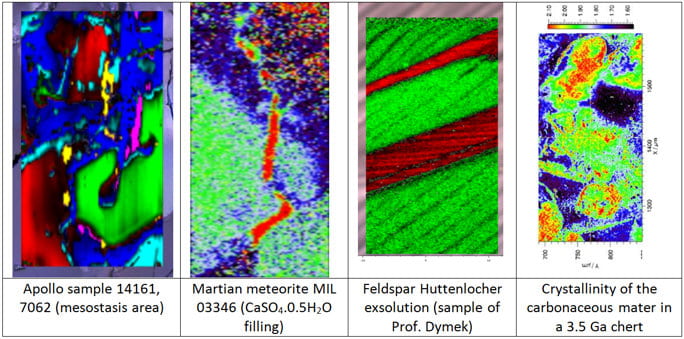Laser Raman Imaging Laboratory
Operating inner room and data processing outer room of Laser Raman imaging laboratory.

This state-of-the-art Raman spectrometer has imaging capability and multi-wavelength excitation. A Raman imaging system will provide molecular maps (similar to the element map provided by an Electron Microprobe). It will collect a Raman image cube from a sample, then generate the map of minerals, molecular species (H2O/OH), and chemical bonds (e.g., C-H, N-H, C-O, C-C, etc). The spatial distributions and spatial correlations of various species will reveal the evidence of past physic-chemical-biologic processes, as well as the genetic relationships among the different species. A Raman system with multiple excitation laser wavelengths is capable to study a wide variety of materials. A different excitation wavelength will affect the Raman cross-sections of materials; sometimes will enhance Raman signals by inducing the Raman resonance effect. More importantly, it will help to overcome the interference of fluorescence generated by some targets.
Raman imaging system – Renishaw InVia
- Five laser wavelengths for Raman excitation from UV to NIR: 325 nm, 442 nm, 532 nm 633 nm, and 785 nm;
- A Raman spectrometer with high spectral resolution (~ 1 cm-1) and wide spectral range (50- 4000 cm-1) for all five excitation wavelengths;
- A microscope with high accuracy moving stage and a wide range of microscopic objectives, 5x, 10x, 20xLWD, 50x, 50xLWD, 100xLWD;
- A microscope with cross-polarization for transmitted light and reflected light for visualization and B/W mosaic imaging;
- Three ways to take Raman spectra and five ways to take Raman images;
- The highest special resolution is 200-300 nm in X-Y and 500 nm in the Z direction.
Sample preparations
- Solid samples — rock chip (less than 1 kg, less than 5 cm height), soils or powders, single gains, films, etc, and no sample preparations are needed. Double-side flat cut surfaces would be preferred for taking Raman images.
- Thin or thick sections — Super-glue is better than epoxy for thin sections; the cover slide and carbon coating (if there is any) should be removed.
- Liquid samples — in a glass bottle, glass capillary, liquid cell, or in a petri dish.
Examples of Raman images

Acknowledgment: the funds for purchasing this top-level Raman Imaging system are from NASA Mars Fundamental Research program — Planetary Major Equipment program, and from Washington University in St. Louis (School of Arts & Sciences, Dept. Earth and Planetary Sciences, and McDonnell Center for Space Sciences).